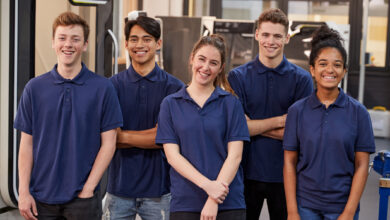
The men and women getting off the plane looked like an army of ancient soldiers marching into the battle, only instead of spears or quivers of arrows each weary traveler carried a thin brown or black tube slung across their shoulders.
As we all marched down the hall toward baggage claim, I turned to one of them. “What’s with all of the tubes,” I asked. “They’re too small for golf clubs.”
He smiled and filled me in. “We’re all presenting posters at a conference this weekend,” he said.
Interestingly enough, I was actually headed to that same conference, not as a researcher but as a journalist. There, I hoped to find some stories about new scientific research and discoveries. I had initially planned on sitting through several hours of breakout sessions, but as it turned out, many of the best ideas that I encountered over the course of the weekend came from the poster sessions.
Yes, the contents of those brown and black tubes.
My experience was hardly unique. Conference poster sessions have become a valuable way for people to get the word out about their research, says Richard House, president of the IEEE Professional Communications Society. “You have a great opportunity to reach a really large audience,” he says. “At many conferences, the poster session is often a lot larger and has far more attendees than individual breakout sessions.”
These events can also help with both your research and your career. “Poster sessions are a great way to get feedback on your work and for you to see what other people in your field are doing,” says Luz Claudio, author of How to Write and Publish a Scientific Paper: The Step-by-Step Guide.
They might also lead to interesting new developments. “Poster sessions are a way to get early exposure, to stimulate discussion, and get insight,” says Tobias Schreck of Graz University of Technology, one of the poster session chairs at IEEE VIS 2016. “Sometimes the poster session interactions can develop into brainstorming sessions in which new ideas are generated by both the presenter and the attendees.”
Of course, before you get that far there’s something you need to tackle first: creating the poster.
Writing & Design
Boiling your research down into an easily digestible single-sheet poster is no easy task.
“It’s like a visual form of the two-minute elevator speech, but you have maybe three seconds to grab people’s attention as they walk by,” says Richard Layton, who, with House and other experts, was one of the authors of The Engineering Communication Manual, which devotes a chapter to poster sessions. Doing that takes a lot of work, and it doesn’t mean simply taking a few PowerPoint slides and slapping them into a poster format. “You need to pay as much attention to a poster as you do to a paper,” he says.
Although exactly what you put into your poster is up to you, you should try to think both visually and minimally. “Some people put too much text in a poster,” says Schreck. “The audience cannot read everything.” Instead, you should use illustrations and bullet points and reduce your text down to as few words as possible. “Don’t just copy and paste most of your paper onto a poster,” House says.
That very process of condensation can prove valuable. By looking at your research from a fresh perspective and thinking about new ways in which to present it, you may gain new insights into the data itself. “It’s a lot of work to prepare a poster,” House says, “but it’s work with a lot of reward and benefit in helping you to think about what’s important in your argument and your findings. You come to appreciate the nuances in your work that you might not have recognized when you first started working on the poster.”
When it comes to design, think about how you are going to stand out from the crowd. “You can grab people’s attention with catchy titles or images,” Layton says.
Another trick is to offer people more than one visual cue through which they can interact with your paper. “The best papers support multiple ways of delivering the content,” says House. “Somebody might be most interested in what your experimental procedure was like, or they might be interested in your findings, or they might be looking for the recommendations that you make based on those findings.” Use bold headlines for each section and place them in a visual way that guides the readers’ eyes. This can help visitors get to the data that’s most important to them.
Of course, a poster doesn’t have to stand on its own. You may also need to prepare for…
The Talk
Many people choose to stand by their posters in order to actively engage passers-by in conversation about their work. “Face-to-face interaction at the posters can be very inspiring,” says Schreck. “It’s an important part of our community.”
If you choose to stand with your poster, that means you have to do more than just write and design what stands on the wall behind you. You also need to be prepared to speak. “Most people who visit your poster will ask you to “walk them through it,'” says Claudio. “It’s best to have an informal presentation ready so you can point out the key points of the poster.”
In fact, you may want to have multiple avenues of discussion prepared and practiced. Just as each person who reads your poster might be interested in a different portion of it, each person you talk with may want to hear about different things. “The pitch you make, or the talk that you give, must be based on the listener’s interest,” Layton says. That means you should be prepared to discuss different things, and maybe even adapt the conversation as people walk up and join in.
That can lead to some very fluid conversations. “The focus is always changing. It’s a little bit of a high-wire act,” Layton says. Some people may be uncomfortable with this, but he argues that it’s an essential part of the process. “In my opinion, the poster is not supposed to be telling the whole story without the presenter there,” he says.
Beyond the Poster
As with any presentation, the final hope is that the conversation about your research continues after your audience walks away. Have business cards handy, and put your contact information on the poster itself. You can also print out copies of your original paper, abstracts, or postcards or flyers with your main points. “You should also plan to get contact information for the people who stop by your poster and follow up with questions or simply a thank-you note after the conference,” Claudio says.
All of this is just one element of broadening the reach of your research and enhancing your communication skills-two things that may help further your career. “Communicating clearly, consistently, truthfully and compellingly in some ways always gives the engineer who’s doing it the path towards promotions and the cool jobs,” Layton says.
And here you thought it was only a poster.







Interesting and makes a lot of sense. My mom, who was an art teacher for years, was also the one responsible for making countless posters for this and that for the school. Not that a school is a business with millions in the balance but the practical points she followed were the same. Simple, striking, intriguing, appealing.